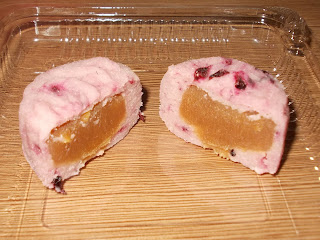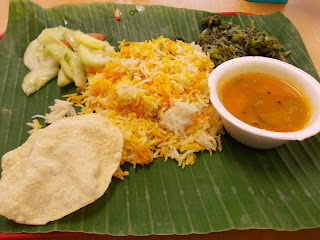Instead of returning to the good vegetarian eateries as promised in the conclusions of my posts, I ended up covering Loving Heart Cafe for the third time. Apart from the pragmatic reason of being within walking distances from my office, it had a revamp recently. Spotting an entirely new menu, it has finally shed the image of being a mere copycat of its neighbor, Kwan Im Vegetarian. The most significnt change is the total removal of their economical rice section. For a blogger like me, this means new material for my posts.
The Food
Ignorance is bliss best summarized my experience with the pumpkin mee jawa at Loving Heart Cafe. Throughout my meal, I was under the impression that I was eating mee rebus which had "mee jawa" as its other alias. For the information of people who are not familiar with mee rebus, it is scalded Chinese yellow noodles mixed with a curry like gravy that contained a sweet undertone from mashed sweet potatoes. Had this been all I knew, I would have easily accepted this dish as not too bad a replica of its non-vegetarian version, which contained shrimps. The use of cheap ingredients like yellow noodles and bean sprouts allowed the vendor to serve generous portion without incurring additional cost, hence keeping the price fairly low at S$ 3.00. Further improvements could be made by adding more pumpkins so as to give the gravy more "pumpkin flavor" as promised in the dish name.
Unfortunately, my habit of going in-depth into the dish after comsumption had unearthed some facts which altered my initial opinion. Despite sounding like "Java", mee jawa does not originate from this Indonesian island. On the contrary, it is considered a Malaysian dish. More importantly, mee jawa is not another name for mee rebus. What distinguished the two is the use of tomato based sauce on top of mashed sweet potatoes in the case of mee jawa. Although I was alright with replacing sweet potatoes with pumpkins for a little twist, the omission of tomato sauce made the dish underserving of its name. I had to admit that the latter feeling arised from knowing a little too much.
Then again, I did not think the pumpkin mee jawa from Loving Heart was a total failure. It was flavorful enough for me at least, but I would definitely not recommend it to anyone looking for authentic and high quality mee jawa.
Several posts ago, I revealed my intention to populate my blog with different kinds of Indian breads. Even though I did not state it explicitly, roti prata was not on my list. Due to my preference for writing about the less common types of food, the relatively ubiquitous roti prata failed to garner my interest. It was a different story when an eatery got innovative and decided to add a little more value to the usual plain prata. While wrapping raw vegetables with roti prata was not exactly an ingenous idea, I did not see any food establishments selling it other than at Loving Heart Restaurant.
Being a fan of raw greens sandwiches and wraps, salad prata instantly clicked with me. Comprising of basic vegetables like lettuce, carrots and cucumbers, the cruchiness of this salad combination complemented well with the roti prata, reminding me of eating a garden salad tortilla wrap. Sweet chilli sauce dominated salad prata with its sweet (duh!) and slighly hot taste, but upon paying a closer attention, one could detect a hint of plum sauce. If the latter flavor was not a figment of my imagination, I might request for the chilli sauce to be left out should I order salad prata in future.
My greatest fear concerning roti prata was being served one that was too soggy and greasy, like the ones sold in my primary school canteen many years ago. Thankfully the roti prata at Loving Heart showed little signs of oil. The characteristic charred sweetness of roti prata was definitely there, which separated it from tortilla and of course the other Indian breads, but it could be better with a crispier exterior and fluffier interior. This S$3.00 dish made a decent side dish, but do not expect it fill you up for a proper meal.
Conclusion
Overall the standard of the food here does not make this eatery a must-visit, even if you live on the other end of Singapore like Jurong or Boon Lay. However for the people nearby in Geylang or Aljunied, it is definitely a viable place have a meal.
The Food
Ignorance is bliss best summarized my experience with the pumpkin mee jawa at Loving Heart Cafe. Throughout my meal, I was under the impression that I was eating mee rebus which had "mee jawa" as its other alias. For the information of people who are not familiar with mee rebus, it is scalded Chinese yellow noodles mixed with a curry like gravy that contained a sweet undertone from mashed sweet potatoes. Had this been all I knew, I would have easily accepted this dish as not too bad a replica of its non-vegetarian version, which contained shrimps. The use of cheap ingredients like yellow noodles and bean sprouts allowed the vendor to serve generous portion without incurring additional cost, hence keeping the price fairly low at S$ 3.00. Further improvements could be made by adding more pumpkins so as to give the gravy more "pumpkin flavor" as promised in the dish name.
Unfortunately, my habit of going in-depth into the dish after comsumption had unearthed some facts which altered my initial opinion. Despite sounding like "Java", mee jawa does not originate from this Indonesian island. On the contrary, it is considered a Malaysian dish. More importantly, mee jawa is not another name for mee rebus. What distinguished the two is the use of tomato based sauce on top of mashed sweet potatoes in the case of mee jawa. Although I was alright with replacing sweet potatoes with pumpkins for a little twist, the omission of tomato sauce made the dish underserving of its name. I had to admit that the latter feeling arised from knowing a little too much.
Then again, I did not think the pumpkin mee jawa from Loving Heart was a total failure. It was flavorful enough for me at least, but I would definitely not recommend it to anyone looking for authentic and high quality mee jawa.
Several posts ago, I revealed my intention to populate my blog with different kinds of Indian breads. Even though I did not state it explicitly, roti prata was not on my list. Due to my preference for writing about the less common types of food, the relatively ubiquitous roti prata failed to garner my interest. It was a different story when an eatery got innovative and decided to add a little more value to the usual plain prata. While wrapping raw vegetables with roti prata was not exactly an ingenous idea, I did not see any food establishments selling it other than at Loving Heart Restaurant.
Being a fan of raw greens sandwiches and wraps, salad prata instantly clicked with me. Comprising of basic vegetables like lettuce, carrots and cucumbers, the cruchiness of this salad combination complemented well with the roti prata, reminding me of eating a garden salad tortilla wrap. Sweet chilli sauce dominated salad prata with its sweet (duh!) and slighly hot taste, but upon paying a closer attention, one could detect a hint of plum sauce. If the latter flavor was not a figment of my imagination, I might request for the chilli sauce to be left out should I order salad prata in future.
My greatest fear concerning roti prata was being served one that was too soggy and greasy, like the ones sold in my primary school canteen many years ago. Thankfully the roti prata at Loving Heart showed little signs of oil. The characteristic charred sweetness of roti prata was definitely there, which separated it from tortilla and of course the other Indian breads, but it could be better with a crispier exterior and fluffier interior. This S$3.00 dish made a decent side dish, but do not expect it fill you up for a proper meal.
Conclusion
Overall the standard of the food here does not make this eatery a must-visit, even if you live on the other end of Singapore like Jurong or Boon Lay. However for the people nearby in Geylang or Aljunied, it is definitely a viable place have a meal.
| Address | : | Blk 134 Geylang East Ave 1 #01-219 Singapore 380134 |
| Opening Hours | : | Mon - Sat, 10.00 am - 10.00 pm Sun 7.00 am - 10.00 pm |
| Bus Service | : | 2, 13, 21, 26, 40, 51 |
| MRT Station | : | Aljunied |
| Website | : | - |











